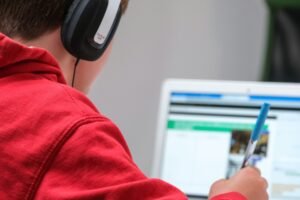
History, Present, and Outlook of the Online Education Sector in Relation to SDG Goal 4
Education is a fundamental right and a key enabler for sustainable development. The United Nations’ Sustainable Development Goal 4 (SDG 4) aims to ensure inclusive and equitable quality education and promote lifelong learning opportunities for all. In recent years, the online education sector has emerged as a powerful tool in advancing this goal, providing access to education regardless of geographical limitations, economic status, or other barriers.
History of Online Education
The concept of online education dates back to the early days of the internet. In the 1990s, universities and institutions began experimenting with delivering courses and educational materials through online platforms. These early efforts laid the foundation for what would become a thriving industry in the following decades.
With the advancements in technology and the widespread availability of the internet, online education has evolved significantly. Today, learners can access a vast array of courses, programs, and educational resources online. From massive open online courses (MOOCs) to virtual classrooms, the options for online learning are diverse and expanding.
The Present State of the Online Education Sector
The online education sector has witnessed tremendous growth in recent years, driven by several factors. Firstly, the increasing demand for flexible learning options has fueled the popularity of online education. Learners can now access courses and programs from top institutions around the world without having to relocate or disrupt their daily lives.
Secondly, the COVID-19 pandemic has accelerated the adoption of online education. With the closure of schools and universities worldwide, online learning became the primary mode of education for millions of students. This unprecedented shift has highlighted the importance and effectiveness of online education in ensuring continuity of learning.
Furthermore, the online education sector has become more inclusive by breaking down traditional barriers to education. Learners from marginalized communities, individuals with disabilities, and those in remote areas now have the opportunity to access quality education that was previously inaccessible to them.
Online Education and SDG Goal 4
The online education sector plays a crucial role in advancing SDG Goal 4. By providing inclusive and equitable access to education, online learning platforms contribute to reducing educational inequalities. Learners from disadvantaged backgrounds can now access high-quality educational resources and bridge the digital divide.
Moreover, online education promotes lifelong learning opportunities. Learners of all ages can engage in continuous education, upskilling, and reskilling to adapt to the changing demands of the job market. This aligns with SDG Goal 4’s objective of promoting lifelong learning for sustainable development.
Additionally, online education fosters innovation in teaching and learning methodologies. Educators can leverage digital tools, interactive platforms, and multimedia resources to enhance the learning experience and cater to diverse learning styles. This innovation in education delivery contributes to the overall improvement of educational quality.
The Outlook for the Online Education Sector
The future of the online education sector looks promising. Technological advancements such as artificial intelligence, virtual reality, and augmented reality are expected to revolutionize the way education is delivered online. These technologies have the potential to create immersive and interactive learning experiences, further enhancing the effectiveness of online education.
Furthermore, the demand for online education is expected to continue growing. The flexibility, accessibility, and cost-effectiveness of online learning make it an attractive option for learners worldwide. Institutions and educators are increasingly recognizing the value of online education and are investing in developing high-quality online courses and programs.
However, challenges remain. Ensuring the quality and credibility of online education is crucial. Institutions and accrediting bodies must establish rigorous standards and guidelines to maintain educational integrity. Additionally, bridging the digital divide and providing access to technology and internet connectivity for all learners is essential in realizing the full potential of online education.
Conclusion
The online education sector has come a long way in contributing to SDG Goal 4. It has transformed the way education is accessed and delivered, providing inclusive and equitable learning opportunities for all. As technology continues to advance and the demand for flexible education grows, the online education sector will play an increasingly vital role in achieving sustainable development through quality education.




